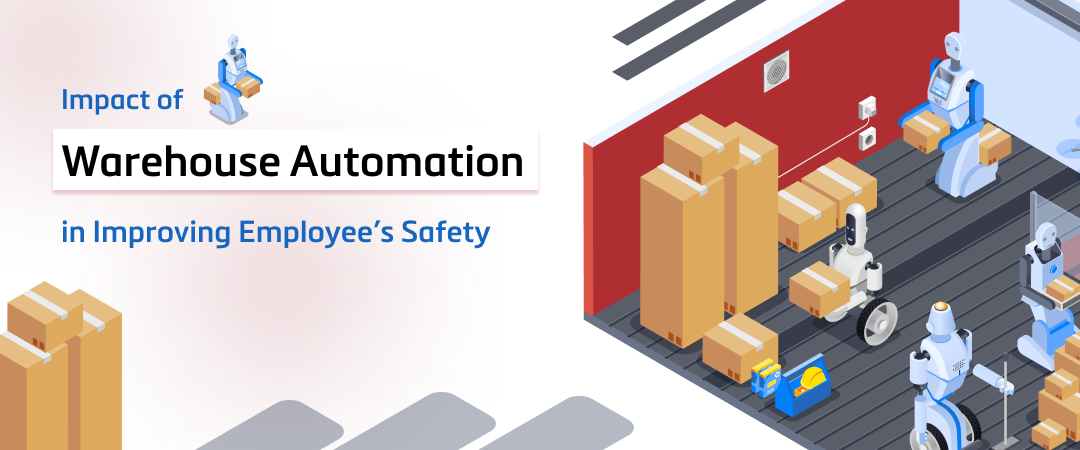
Impact of Warehouse Automation in Improving Employees’ Safety

The health and safety of employees is one of the most important aspects of warehouse operations. In recent days, the warehouses are witnessing lots of advancements with the application of automation technologies. The Occupational Safety and Health Administration (OSHA) states that warehouse automation have the capability to handle loading and unloading, welding or machines while working in hazardous environments and other situations that leads to workplace injuries. In this, let’s have a look at the impact of warehouse automation on improving employees’ safety.
What Is Warehouse Automation?
Warehouse automation is the system of automating the inventory operations right from receiving goods to space utilization, enhancing warehouse productivity to improving employees’ safety. With automation, warehouses can eliminate works that involve repetitive physical work, reduce operational cost because of decreased manual output (because of automation replacing manual works)
Wondering How Warehouse Automation Works? Request a Free Demo | WhatsApp
Classifications of Warehouse Automation
Warehouse automation can be classified into several categories starting from automating relatively simple tasks to automating tasks that are highly complex. Basic automation involves automating routine tasks like inventory planning, data collection, inventory audits and dock scheduling. Likewise, advance warehouse automation involves activities like automated forecasting and planning, AI-driven predictive maintenance systems, and so on.
Warehouse automation categories include:
1. Basic Warehouse Automation
It is a type of automation where simple technology is used to assist the warehouse with tasks that would rather need high manual labor. For example, an automation system that will automatically notify the warehouse managers to reorder products when inventory levels fall below predefined measures.
2. Warehouse System Automation
It is a type of system that uses software, machine learning, AI and data analytics to automate tasks and procedures. For example, AI-integrated predictive maintenance that analyzes data from warehouse equipment to predict potential failures before it occurs.
3. Mechanized Warehouse Automation
This type of warehouse automation uses robotic systems to replace humans for warehouse tasks and procedures. Example, an automated retrieval system that utilizes robotic arms to pick items from storage locations based on incoming orders.
4. Advanced Warehouse Automation
Advanced warehouse automation that blends mechanized warehouse robotics and automation systems that replaces increased physical tasks. For example, integrating multiple systems that can handle orders from various sales channels and automates the fulfillment process.
Role of Warehouse Automation in Enhancing Employees’ Safety
Advancements in automation help warehouse businesses to streamline their material handling along with eliminating labor shortages and reducing operating costs. Along with that, warehouse automation is also improving the safety of employees in their day-to-day operations.
Less Human Errors
Negligence and ignorance of Human errors might lead to accidents in a warehouse, especially when dealing with heavy equipment and machinery. By automating specific tasks, you can massively reduce human errors and prevent risks. Machines and robots are designed to carry on tasks accurately and consistently, and eliminate the human errors occurring due to human factors like fatigue or distraction.
Reduced Physical Strain
Excessive manual tasks which are physically exhausting, leading to injury or long-term health issues such as repetitive strain injury (RSI). Automating tasks that involve heavy physical strain like heavy lifting and transporting goods will massively reduce the physical employee strain that in turn thereby decreases the risk of injuries and health issues.
Better hazard identification
Automation aids to easily rectify hazards that may not be instantly apparent to employees. For example, sensors on machines and equipment will detect when an employee is too close to be moving parts and automatically shuts down the machine. This eventually protects accidents and injuries that may have been resistant to avoid without automation.
Wondering How Warehouse Automation Works? Request a Free Demo | WhatsApp
Reduced risk of accidents
By enhancing safety via automation, warehouses can significantly reduce the risk of accidents. This can reduce employees’ compensation claims, insurance dues, and missed productivity due to accidents.
AR and VR Application
For training purposes, automation is used to create “sandbox environments” to replicate realistic scenarios in which employees can learn without the current risks of a completely functioning facility. Augmented reality (AR) and virtual reality (VR) applications can be used to safely gamify certain employee onboarding and repetitive needs for a warehouse facility.
Space Utilization
Automated storage systems like vertical carousels and shuttle systems helps to optimize the space of warehouse space effectively. These systems helps to store items within a limited space better than traditional storage systems. This allows for more storage capacity in the same space. This is specifically advantageous for businesses which have little storage space but have to store high volume of goods.
Effective inventory management
Automated systems help to enhance inventory management by offering real-time visibility into inventory volumes. This helps businesses eliminate understocking or overstocking or overstocking products which prevents organizations from lost sales or wasted inventory.
Take Away
As warehousing automation is evolving as the next big technology, many warehouse businesses are trying to gain maximum benefits out of it. From improving employee safety to increasing employee productivity, warehouse automation plays a prime role in reducing manual and physical strains.
With iSQUARE’s Warehouse Automation Software, you can automate your warehouse activities effortlessly. Our customized warehouse automation software helps to lower the risk of injuries that occur from repetitive tasks and capitalize on the safety features of warehouse operations. Interested in automating your warehouse business and enhance employee safety? Schedule a call with our team of experts!














